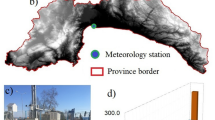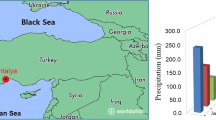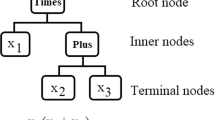Abstract
The evolution of ensemble learning has recently offered a new approach to model complex systems. Inspired by the success of such methods, this paper introduces a new ensemble approach that integrates capabilities of two top state-of-the-art machine learning (ML) methods, namely random forests (RF) and genetic programming (GP), to model and forecast meteorological drought onset and severity. The new method, called gene-random forest (GeRF), follows the same steps of a standard GP systems, but with differences in the generation of initial population of potential solutions. The GeRF was tested to model and predict standardized precipitation evapotranspiration indices (SPEI-3 and SPEI-6) at two meteorology stations in Ankara province, Turkey. We have compared its efficiency to those of a classic autoregressive model as well as standalone RF, GP, and a hybrid ML model, called Bat-ELM, achieving results meaningfully superior to the benchmarks, particularly in the testing data.





Similar content being viewed by others
References
AghaKouchak, A., Pan, B., Mazdiyasni, O., Sadegh, M., Jiwa, S., Zhang, W., & Sorooshian, S. (2022). Status and prospects for drought forecasting: opportunities in artificial intelligence and hybrid physical–statistical forecasting. Philosophical Transactions of the Royal Society A, 380(2238), 20210288.
Aghelpour, P., Mohammadi, B., Mehdizadeh, S., Bahrami-Pichaghchi, H., & Duan, Z. (2021). A novel hybrid dragonfly optimization algorithm for agricultural drought prediction. Stochastic Environmental Research and Risk Assessment, 35(12), 2459–2477.
Ahmadi, F., Mehdizadeh, S., & Mohammadi, B. (2021). Development of bio-inspired-and wavelet-based hybrid models for reconnaissance drought index modeling. Water Resources Management, 35(12), 4127–4147.
Al-Helali, B., Chen, Q., Xue, B., & Zhang, M. (2020, April). Hessian complexity measure for genetic programming-based imputation predictor selection in symbolic regression with incomplete data. In: European Conference on Genetic Programming (Part of EvoStar) (pp. 1–17). Springer, Cham
Alizamir, M., Heddam, S., Kim, S., & Mehr, A. D. (2021). On the implementation of a novel data-intelligence model based on extreme learning machine optimized by bat algorithm for estimating daily chlorophyll-a concentration: case studies of river and lake in USA. Journal of Cleaner Production, 285, 124868.
Beyaztas, U., & Yaseen, Z. M. (2019). Drought interval simulation using functional data analysis. Journal of Hydrology, 579, 124141.
Belayneh, A., Adamowski, J., Khalil, B., & Ozga-Zielinski, B. (2014). Long-term SPI drought forecasting in the Awash River Basin in Ethiopia using wavelet neural network and wavelet support vector regression models. Journal of Hydrology, 508, 418–429.
Breiman, L. (2001). Random forests. Machine Learning, 45(1), 5–32.
Dai, A. (2013). Increasing drought under global warming in observations and models. Nature Climate Change, 3, 52–58.
Danandeh Mehr, A. (2021). Drought classification using gradient boosting decision tree. Acta Geophysica, 69, 909–918.
Danandeh Mehr, A., Kahya, E., & Özger, M. (2014). A gene-wavelet model for long lead time drought forecasting. Journal of Hydrology, 517, 691–699.
Danandeh Mehr, A., & Vaheddoost, B. (2020). Identification of the trends associated with the SPI and SPEI indices across Ankara, Turkey. Theoretical and Applied Climatology, 139(3), 1531–1542.
Deo, R. C., Tiwari, M. K., Adamowski, J. F., & Quilty, J. M. (2017). Forecasting effective drought index using a wavelet extreme learning machine (W-ELM) model. Stochastic Environmental Research and Risk Assessment, 31(5), 1211–1240.
Dong, L., Zeng, W., Wu, L., Lei, G., Chen, H., Srivastava, A. K., & Gaiser, T. (2021). Estimating the pan evaporation in Northwest China by coupling CatBoost with Bat algorithm. Water, 13(3), 256.
Fernando, T. M. K. G., Maier, H. R., & Dandy, G. C. (2009). Selection of input variables for data driven models: an average shifted histogram partial mutual information estimator approach. Journal of Hydrology, 367(3–4), 165–176.
Gholizadeh, R., Yılmaz, H., & Danandeh Mehr, A. (2022). Multitemporal meteorological drought forecasting using Bat-ELM. Acta Geophysica, 70(2), 917–927.
Han, Y., Wu, J., Zhai, B., Pan, Y., Huang, G., Wu, L., & Zeng, W. (2019). Coupling a bat algorithm with xgboost to estimate reference evapotranspiration in the arid and semiarid regions of China. Advances in Meteorology, 2019, 1–16.
Hoegh-Guldberg, O., Jacob, D., Bindi, M., Brown, S., Camilloni, I., Diedhiou, A., ... & Zougmoré, R. B. (2018). Impacts of 1.5 °C global warming on natural and human systems. In: Masson-Delmotte, V., Zhai, P., Pörtner, H. O., Roberts, D., Skea, J., Shukla, P. R., Pirani, A., Moufouma-Okia, W., Péan, C., Pidcock, R., Connors, S., Matthews, J. B. R., Chen, Y., Zhou, X., Gomis, M. I., Lonnoy, E., Maycock, T., Tignor, M., & T Waterfield (eds) , Global warming of 1.5 °C. : An IPCC Special Report. IPCC Secretariat, pp. 175–311. http://hdl.handle.net/10138/311749
Jagadeesh, B., & Sree, D. V. V. (2022). Detection and recognition of traffic sign boards using random forest classifier. Review of Computer Engineering Research, 9(3), 135–149. https://doi.org/10.18488/76.v9i3.3109
Karbassi, A., Maghrebi, M., Noori, R., Lak, R., & Sadrinasab, M. (2020). Investigation of spatiotemporal variation of drought in Iran during the last five decades. Desert, 25(2), 213–226.
Khan, M. M. H., Muhammad, N. S., & El-Shafie, A. (2020). Wavelet based hybrid ANN-ARIMA models for meteorological drought forecasting. Journal of Hydrology, 590, 125380.
Kisi, O., Gorgij, A. D., Zounemat-Kermani, M., Mahdavi-Meymand, A., & Kim, S. (2019). Drought forecasting using novel heuristic methods in a semi-arid environment. Journal of Hydrology, 578, 124053.
Li, J., Wang, Z., Wu, X., Xu, C. Y., Guo, S., Chen, X., & Zhang, Z. (2021). Robust meteorological drought prediction using antecedent SST fluctuations and machine learning. Water Resources Research, 57(8), e2020WR029413.
Mehdizadeh, S., Ahmadi, F., Mehr, A. D., & Safari, M. J. S. (2020). Drought modeling using classic time series and hybrid wavelet-gene expression programming models. Journal of Hydrology, 587, 125017.
Mehr, A. D. (2021). Seasonal rainfall hindcasting using ensemble multi-stage genetic programming. Theoretical and Applied Climatology, 143(1), 461–472.
Mehr, A. D., Tur, R., Çalışkan, C., & Tas, E. (2020). A novel fuzzy random forest model for meteorological drought classification and prediction in ungauged catchments. Pure and Applied Geophysics, 177(12), 5993–6006.
Mishra, A. K., & Desai, V. R. (2005). Drought forecasting using stochastic models. Stochastic Environmental Research and Risk Assessment, 19(5), 326–339.
Morid, S., Smakhtin, V., & Bagherzadeh, K. (2007). Drought forecasting using artificial neural networks and time series of drought indices. International Journal of Climatology: A Journal of the Royal Meteorological Society, 27(15), 2103–2111.
Özger, M., Mishra, A. K., & Singh, V. P. (2011). Long lead time drought forecasting using a wavelet and fuzzy logic combination model: a case study in Texas. Journal of Hydrometeorology, 13, 284–297. https://doi.org/10.1175/jhm-d-10-05007.1
Park, H., Kim, K., & Lee, D. (2019). Prediction of severe drought area based on random forest: using satellite image and topography data. Water, 11(4), 705.
Prodhan, F. A., Zhang, J., Hasan, S. S., Sharma, T. P. P., & Mohana, H. P. (2022). A review of machine learning methods for drought hazard monitoring and forecasting: current research trends, challenges, and future research directions. Environmental Modelling & Software, 149, 105327.
Rahmani-Rezaeieh, A., Mohammadi, M., & Danandeh Mehr, A. (2020). Ensemble gene expression programming: a new approach for evolution of parsimonious streamflow forecasting model. Theoretical and Applied Climatology, 139(1), 549–564.
Rezaie-Balf, M., Fani Nowbandegani, S., Samadi, S. Z., Fallah, H., & Alaghmand, S. (2019). An ensemble decomposition-based artificial intelligence approach for daily streamflow prediction. Water, 11(4), 709.
Silva, S., & Almeida, J.: GPLAB a genetic programming toolbox for MATLAB (2007). http://gplab.sourceforge.net/index.html
Song, X., Song, Y., & Chen, Y. (2020). Secular trend of global drought since 1950. Environmental Research Letters, 15(9), 094073.
Tirivarombo, S., Osupile, D., & Eliasson, P. (2018). Drought monitoring and analysis: standardised precipitation evapotranspiration index (SPEI) and standardised precipitation index (SPI). Physics and Chemistry of the Earth, Parts A/B/C, 106, 1–10.
Vaheddoost, B., & Safari, M. J. S. (2021). Application of signal processing in tracking meteorological drought in a mountainous region. Pure and Applied Geophysics, 178, 1943–1957.
van der Wiel, K., Wanders, N., Selten, F. M., & Bierkens, M. F. P. (2019). Added value of large ensemble simulations for assessing extreme river discharge in a 2 °C warmer world. Geophysical Research Letters, 46, 2093–2102.
Van Loon, A. F., Tijdeman, E., Wanders, N., Van Lanen, H. J., Teuling, A. J., & Uijlenhoet, R. (2014). How climate seasonality modifies drought duration and deficit. Journal of Geophysical Research: Atmospheres, 119(8), 4640–4656.
Vicente-Serrano, S. M., Beguería, S., & López-Moreno, J. I. (2010). A multiscalar drought index sensitive to global warming: the standardized precipitation evapotranspiration index. Journal of Climate, 23, 1696–1718.
Wallis, J. R., & Matalas, N. C. (1971). Correlogram analysis revisited. Water Resources Research, 7(6), 1448–1459.
Yaseen, Z. M., Ali, M., Sharafati, A., Al-Ansari, N., & Shahid, S. (2021). Forecasting standardized precipitation index using data intelligence models: regional investigation of Bangladesh. Scientific Reports, 11(1), 1–25.
Zounemat-Kermani, M., Batelaan, O., Fadaee, M., & Hinkelmann, R. (2021). Ensemble machine learning paradigms in hydrology: a review. Journal of Hydrology, 598, 126266.
Funding
The authors have received no funding for this study.
Author information
Authors and Affiliations
Corresponding author
Ethics declarations
Conflict of Interest
The authors declare that they have no conflict of interest.
Additional information
Publisher's Note
Springer Nature remains neutral with regard to jurisdictional claims in published maps and institutional affiliations.
Rights and permissions
Springer Nature or its licensor (e.g. a society or other partner) holds exclusive rights to this article under a publishing agreement with the author(s) or other rightsholder(s); author self-archiving of the accepted manuscript version of this article is solely governed by the terms of such publishing agreement and applicable law.
About this article
Cite this article
Danandeh Mehr, A. A Gene-Random Forest Model for Meteorological Drought Prediction. Pure Appl. Geophys. 180, 2927–2937 (2023). https://doi.org/10.1007/s00024-023-03283-1
Received:
Revised:
Accepted:
Published:
Issue Date:
DOI: https://doi.org/10.1007/s00024-023-03283-1




